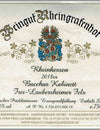
When discussing Bordeaux, it is important to recognize the distinguishing characteristics of those that come from the Right bank vs. the Left bank. Perhaps you’ve heard the terminology before, or you’re new to the nuances of Bordeaux wines, but understanding the differences between them can help you choose the right bottle for any occasion.
What Does Left vs. Right Mean?
Bordeaux wine comes from, of course, the Bordeaux region of France. Here the Gironde Estuary, a few rivers meet the ocean, splitting the region into the Left and Right banks. For a better idea of these banks’ locations, if you were to stand in Bordeaux and face west towards the ocean, the Left is located south of the Garonne and Gironde rivers, and the Right is north of the Dordogne and Gironde rivers. Although they share the same region, the land itself is different depending on the bank. The Left has rockier, gravel-packed soil with deep deposits of limestone, whereas the Right has less gravel for the vines to grow through, and the limestone is closer to the top of the soil.
Bordeaux Wines from Left & Right
While the Left sounds like it wouldn’t be great for growing much of anything, the vine struggling for nutrients actually produces a great product with character and quality, lending to wines that do better with aging. This does not make it better than those from the Right, as they are still known to have their own character, but are much smoother and typically better to drink sooner than later.
Thanks to this difference in growth environment, different varieties of grapes are also grown within each bank. Wines from the Left bank will be mostly Cabernet Sauvignon with Merlot, while those from the Right are, in a way, the reverse, with mostly Merlot balanced by Cabernet. Even the chateaux are different based on the bank they are located. The Left is host to those that resemble small castles and the Right tend to be on smaller plots of land (although not necessarily any less grand in appearance).
Again, wines chosen from either bank within the Bordeaux region will satisfy. There are many great selections that come from each area, with various vineyards and chateaux to choose from. One specifically located on the Right bank, Chateau Bonalgue, is one we are proud to offer at Garland Wines.
Chateau Bonalgue Pomerol
The original chateau was built in 1815 by the Rabion family and was called Clos Bonalgue, named after the sector where the vines are planted, Graves de Bonalgue. In 1926, the Bourette family purchased the chateau, and the name was later changed to Chateau Bonalgue in 1969. The Bourette family continues to own the vineyard today.
To get the fullest enjoyment from a bottle, it is important to know when it reaches maturity or how long it should be decanted. Good vintage wines from Chateau Bonalgue are recommended to have at least 2 – 4 years of aging. If the vintage is young, decanting for an hour is sufficient enough to soften it and open its perfume. Peak maturity for these wines is between 4 – 12 years after the vintage.
If you are in search of an excellent Bordeaux at Garland Wines, we offer the 2015 Chateau Bonalgue (Pomerol). This specific selection starts with a touch of oak on the nose, followed by earthy, plummy fruits and truffle. It is medium-bodied and boasts soft, textured finishes with fresh, spicy and earthy red fruits. This wine is best enjoyed with meat dishes, such as veal, pork, beef, lamb and roast chicken, as well as Asian dishes, tuna, mushrooms and pasta.
To find this and other great wines, visit us in-store, view our online shop or contact us today. Our goal is to provide customers with premium quality wines from small family-owned and operated vineyards from around the world.




